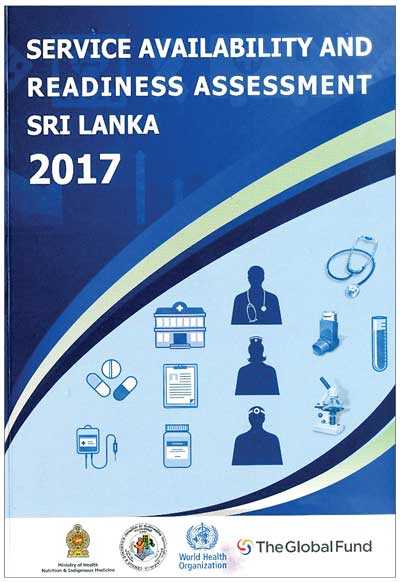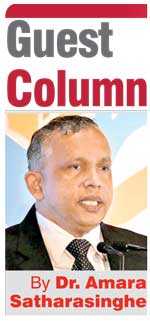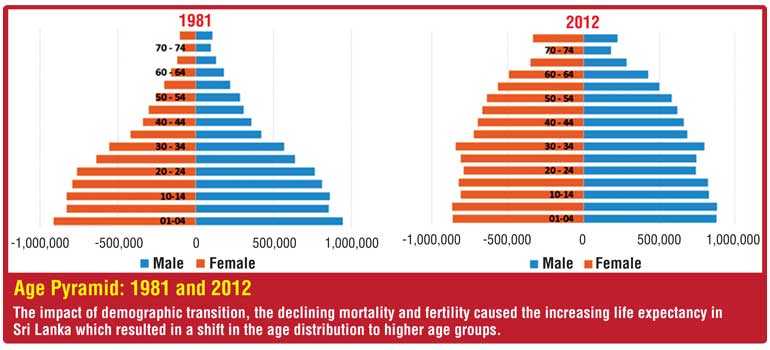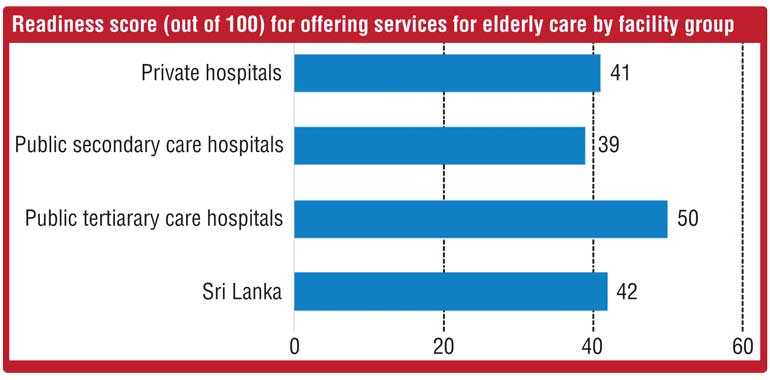Tuesday Mar 18, 2025
Tuesday Mar 18, 2025
Tuesday, 5 March 2019 00:05 - - {{hitsCtrl.values.hits}}
Median age of the population of Sri Lanka is increasing because of declines in fertility and mortality rates. The growing number of older adults increases demands on the public health system and on medical and social services. Chronic diseases, which affect older adults disproportionately, contribute to disability, diminished quality of life, and increased health and long-term care costs.
Increased life expectancy reflects, in part, the success of public health interventions, but public health programs must now respond to the challenges created by this achievement, including the growing burden of chronic illnesses, injuries, disabilities, psychological disorders and increasing concerns about future caregiving and healthcare costs.

Geriatrics, or geriatric medical care, is a specialty that focuses on healthcare of elderly people. It aims to promote health by preventing and treating diseases and disabilities in older adults. As people age, their physical health becomes fragile. Their psychological health too becomes increasingly at risk because of the impact of negative life events such as accumulated traumatic experiences, and poor social and economic factors. Healthcare of the elderly needs to therefore be responsive to these conditions to provide an elderly-friendly service. However, up to now there has hardly been any information on geriatric facilities available in the public and private health institutions.
It is timely that the Ministry of Health and Indigenous Medicine and the Department of Census and Statistics (DCS) in collaboration has conducted a survey on Service Availability and Readiness Assessment of Health Institutions in Sri Lanka in 2017. Among other much valued information, the report of this survey fulfils a major requirement for the planners, administrators and policy makers of health in identifying the level of availability of health services in the institutions for elderly care, capacity of the institutions to provide the elderly care services and which components in the chain of elderly healthcare delivery need more attention and improvement, so that a quality health service for the growing elderly population is available and delivered.
Growing elderly population
The elderly population in Sri Lanka has grown rapidly in the past several decades. They were an unprecedented 2.5 million in 2012, and this is still increasing. One in eight Sri Lankans is 60 years or over. According to unpublished data, by the year 2017, elderly population has reached the level of 16%. This is in contrast to about a sparse one in 20 persons a few decades ago. Demographers project that the aged will double by 2041. Every fourth person in the country will then be an elderly. The numerical growth of the elderly has been happening almost invisibly and inaudibly. Sri Lanka has progressed through a demographic transition of declining mortality and fertility rates. Starting mid 1940s the death rate declined from 19.6 to 6.0 per thousand. Subsequently, the fertility rate or the average number of children born to a woman also began a downward trend declining from 5.5 to 2.4. Declining mortality is reflected in the steadily rising life expectancy at birth.

There are certain health conditions that are expected to be a challenge to our healthcare system with the increasing ageing population. These conditions include chronic illnesses such as cancer, obesity, diabetes, and psychological disorders such as dementia and Alzheimer’s. The elderly are also increasingly likely to suffer from accidental falls.
Health status of the elderly population
The changing age structure has many and serious implications in almost all aspects of life. The disease profile has already changed from a predominance of infectious and acute diseases to rising chronic, degenerative, and expensive-to-treat diseases. The ageing population will increasingly put pressure on health systems with the rise of chronic cancer, diabetes and cardiovascular diseases etc.
DCS in collaboration with the Faculty of Community Medicine of the University of Colombo has conducted a year-long household survey on health in 2014 covering the entire country. Data collected in this survey include: Prevalence of illnesses – both chronic and acute, place from which the treatments were received, accidents, place of accident, health screening, smoking and alcohol use, possession of health insurance, etc. This survey has shown that chronic illness, as can be expected, increases with age. Almost 55% of the elderly population suffers from at least one chronic illness. That is one in two of elderly persons is living with a chronic illness. This implies living with pain, discomfort, inconvenience, and continuing life-long medication.

Readiness for geriatric healthcare
Service Availability and Readiness Assessment (SARA) of health institutions, is a survey conducted by countries, at regular intervals to assess and monitor the availability of the health services and the readiness of the health institutions to provide expected services. These surveys generate evidence to support policy reforms, planning, implementing and monitoring the health services provided by the health system. A SARA survey was conducted for the first time in Sri Lanka in 2017 jointly by the DCS and Ministry of Health and Indigenous Medicine, fulfilling a long-felt need.
This survey covered several service areas including maternal and child health, infectious diseases such as human HIV/AIDS and other sexually transmitted infections, tuberculosis, malaria, rabies and dengue; chronic non-communicable disease including diabetes, cardiovascular disease, chronic obstructive pulmonary disease, chronic kidney disease and cancer; mental health; care for elders and the disabled; and gender-based violence.
SARA Sri Lanka – 2017 measured the overall availability and readiness of each of the services provided through the network of government and private sector healthcare institutions.
Objectives of the SARA survey
One of the objectives of the survey was to describe the availability of general health services in terms of basic amenities (infrastructure), basic equipment, diagnostic capacities, standard precautions, essential medicines, surgical management, and transfusion services in the state sector and private sector health facilities in Sri Lanka. To describe the availability of trained staff, equipment, diagnostic capacities and medicines/commodities to deliver services related to key health areas; assess the readiness of the health facilities to deliver general health services; assess the readiness of the facilities to deliver services were other objectives. Because of the rapidly growing demand, information was gathered on elderly care service availability and readiness also.

Service availability
In general service availability in health institutions is very impressive. Among the basic amenities, a source of improved water supply was available in almost all health facilities (99%), and the sanitation facilities were available in approximately 91% of public health facilities and all private hospitals (100%). Emergency transport service was available in a great majority of public hospitals (91% to 100%). Availability of basic equipment was high in all facilities especially those with in-ward facilities. Most individual tracer items required for standard precautions were available in more than 80% of health facilities. The percentage of facilities offering primary laboratory tests was high for blood glucose test using glucometer.
However, there was a wide variation in the availability across different types of facilities. Availability of advanced laboratory tests such as liver and renal function tests was low among all health facilities. However, lipid profile testing was available in a large percentage of tertiary care hospitals and private hospitals with more than 50 beds, but low in other facilities. Availability of radiological tests (X-ray) was high, and found in most tertiary care hospitals (95%), secondary care hospitals (79%), and private hospitals with more than 50 beds (89%).
Service readiness index
According to the report SARA – 2017, the general service readiness index is a composite measure designed to combine information from five domains namely, basic amenities, basic equipment, standard precautions, laboratory diagnostics, and essential medicines. The results revealed that general service readiness index score for hospitals in Sri Lanka was 79 out of 100, with a score of 77 out of 100 in public sector health facilities and 83 out of 100 in private sector health facilities.
Service availability and readiness for elderly care
Older people have a need for more health monitoring and treatment than younger people and the pattern and causes of their illness are different. They need extraordinary care and geriatric treatments that are expensive. Therefore, the provision of long-term healthcare is a serious issue. Promoting healthy lifestyles and broadening the use of clinical preventative services are critical to preserving the health of older adults and reducing healthcare costs and long-term care needs. The SARA – 2017 reveals that the availability of elderly friendly wards was as low as 20% among all hospitals that are expected to provide this service. Only 18% of public health facilities, and 22% of private hospitals had elderly-friendly wards. Availability of health staff with training on care for elderly was extremely low, as indicated by low presence of trained medical officers/consultants (7%), nursing officers (7%), attendants (6%) and labourers (4%) at health facilities.
The readiness for elderly care services has been assessed based on availability of staff trained in elderly healthcare, equipment required for elderly and accessible facilities such as accessible ramps, toilets with commodes and supporting bars, and wide doorways. The overall readiness score for elderly care services in all health institutions has been estimated as 42 out of 100 at national level. Only 5% of health facilities had all tracer items.
Conclusion
Healthcare systems in all countries continue to evolve in response to changing demographics and disease burden and rapid technological advances. The SARA Sri Lanka 2017 report provides scientifically valid baseline data to inform policy decisions and strategic planning and scaling-up of the health services in the health sector, focusing on service availability and readiness in public and private sector health facilities in Sri Lanka.
Since overall service availability and readiness are low in the elderly care, there is a need to consider more investments for these services in Sri Lanka. The relevant categories of health staff should be trained on care for elderly, together with expansion of services for elderly care to lower level hospitals. To conclude, provision of quality assured healthcare services for the elderly population is a challenge that requires a multi-sectoral approach and strategies. Failure to address the health needs today could develop into a costly problem tomorrow.
(The writer is Former Director General of Census and Statistics.)
Discover Kapruka, the leading online shopping platform in Sri Lanka, where you can conveniently send Gifts and Flowers to your loved ones for any event including Valentine ’s Day. Explore a wide range of popular Shopping Categories on Kapruka, including Toys, Groceries, Electronics, Birthday Cakes, Fruits, Chocolates, Flower Bouquets, Clothing, Watches, Lingerie, Gift Sets and Jewellery. Also if you’re interested in selling with Kapruka, Partner Central by Kapruka is the best solution to start with. Moreover, through Kapruka Global Shop, you can also enjoy the convenience of purchasing products from renowned platforms like Amazon and eBay and have them delivered to Sri Lanka.
Discover Kapruka, the leading online shopping platform in Sri Lanka, where you can conveniently send Gifts and Flowers to your loved ones for any event including Valentine ’s Day. Explore a wide range of popular Shopping Categories on Kapruka, including Toys, Groceries, Electronics, Birthday Cakes, Fruits, Chocolates, Flower Bouquets, Clothing, Watches, Lingerie, Gift Sets and Jewellery. Also if you’re interested in selling with Kapruka, Partner Central by Kapruka is the best solution to start with. Moreover, through Kapruka Global Shop, you can also enjoy the convenience of purchasing products from renowned platforms like Amazon and eBay and have them delivered to Sri Lanka.